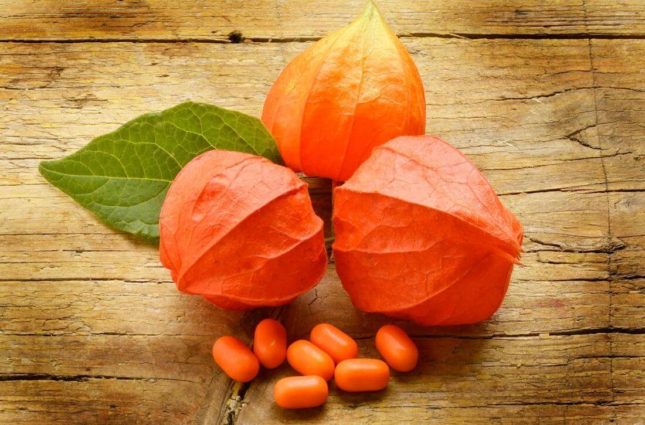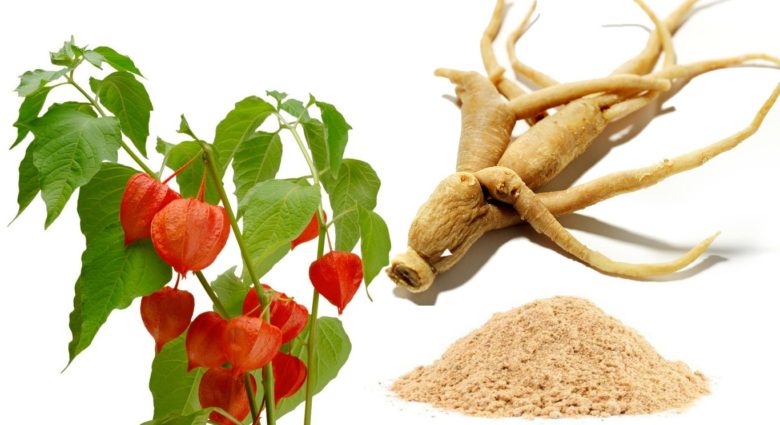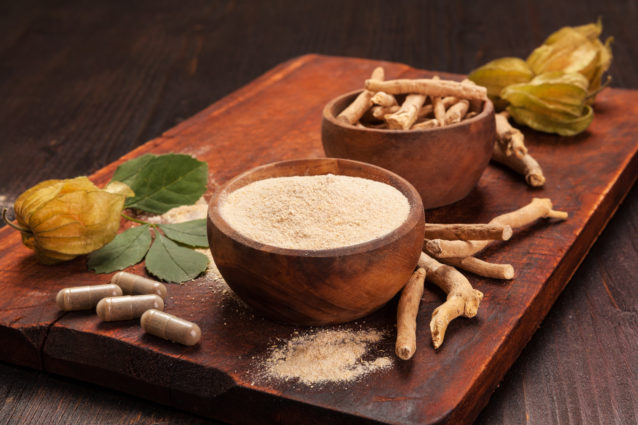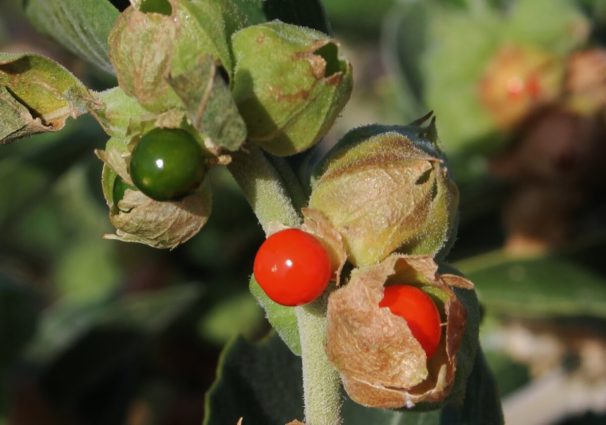ASHWAGANDHA

Ashwagandha, having a wide range of effects on the human body, has been used by Ayurvedic doctors for many millennia as Rasayana, i.e. a plant with a pronounced anti-aging effect.
Being a natural adaptogen, Ashwagandha promotes the adaptation of the body to sudden climate changes, to adverse geophysical, meteorological, and man-made impacts.
As an anabolic, Ashwagandha increases muscle strength and increases the body’s endurance in extreme circumstances.
As a nootropic, it improves brain function, strengthens memory, and increases learning ability. Ashwagandha has a positive effect on the activity of the brain, central nervous system, and other functions of the body, aimed at overcoming the effects of stress. It relieves chronic fatigue, stress, depression, tones up, improves performance. The most important advantage is it is calming and at the same time tonic effect on the nervous system. Ashwagandha restores the basic energy of the nervous system and the effect of its reception persists for a long time. Despite the fact that ashwagandha refers to tonics, it does not increase blood pressure.

As an antioxidant, Ashwagandha is a rejuvenating agent, removes cellular “garbage” and products of incomplete metabolism, protects the body’s cells from damage by environmental factors, and increases their reproductive period.
Ashwagandha increases the body’s resistance to infections and improves digestion, as an immunomodulator, Ashwagandha normalizes the body’s immune response, its protective properties against various infections.
Ashwagandha has an effect on all the organs of the body. Its high biological activity is associated with a high content of phytosteroids, lignins, flavonoglycosides, as well as special nitrogenous compounds of vitanloids (somniferin and vitanon). The latter have the strongest effect, despite the fact that they make up only 1.5% in relation to the rest of the chemical components of the plant.
Description of the action of Ashwagandha
It normalizes the energy balance of the body during a two-week course (600 mg per day). With the further intake of this plant for 7-10 days of each month, the energy balance is maintained at a normal level, even despite the continued effect of the above negative factors on the body. Adaptogenic, nootropic, antidepressant, and tonic effects are associated with the action of vitanloids (somniferin and vitanon). Vitanon, contained in Ashwagandha, stabilizes the activity of neurons, eliminates seizures, balances the state of the nervous system, normalizes the functions of the hypothalamus, vasomotor and respiratory centers, and accelerates the breakdown of adrenaline. Ashwagandha acts as a tuning fork for the central nervous system, ensuring its harmony with the environment and internal organs.
Recent studies in China have found that Ashwagandha has anti-cancer activity and is effective in many cancers. Clinical trials of Ashwagandha, conducted in the United States, showed that long-term use of this plant (4-5 months continuously) normalizes the metabolism of estrogens and thereby prevents the development of fibromyomas and mastopathy. In addition, the majority of the examined women had the elimination of dysmenorrhea, and oligomenorrhea-menstruation began to occur regularly and painlessly. American researchers say that the latter effect is most likely associated with the action of vitanloids. Ashwagandha is considered a male plant, but for some diseases, it is recommended to take it for women, at the same time including female plants (for example, Shatavari).
In addition, natural antibiotics have been found in Ashwagandha that suppresses the reproduction of gonococci, staphylococci, hemolytic streptococcus, and Coli bacteria. Some researchers point to the antiviral effect of the plant. Perhaps this is due to the fact that vitanloids increase the activity of a non-specific link of immunity.
Ashwagandha reduces the need for sweets, chocolate, flour, and alcohol. Breaks down excess fat, converting it into muscle mass.
Ashwagandha is often used in cosmetics to soften, tone, and rejuvenate the skin. Ashwagandha normalizes its water balance, eliminates tissue acidosis. The astringent substances contained in Ashwagandha make the skin as smooth as porcelain.
Ashwagandha mechanism of action:
High biological activity is associated with the presence of phytosterols, lignans, flavonol glycosides, as well as special nitrogenous compounds of vitanloids (somniferin and vitanon). Vitanon stabilizes the activity of neurons, eliminates seizures, balances the state of the nervous system, normalizes the functions of the hypothalamus, vasomotor and respiratory centers, accelerates the breakdown of adrenaline. It provides sedative, hypotensive, anticonvulsant, and anti-stress effects on the body. Vitanloids, especially somniferin, increase the activity of the enzymes peroxide dismutase and catalase, increasing the antioxidant protection of cell membranes. Somniferin converts glucose oxidation to the aerobic pathway, even in tissues experiencing hypoxia.
Phytosterols stimulate the secretion of prostate juice in men, prevent the destruction of testosterone, prevent the development of adenoma and prostate cancer. In women, it normalizes the metabolism of estrogens and prevents the development of uterine fibroids, endometriosis, mastopathy, normalizes the menstrual cycle.
Ashwagandha recommendations:
It is traditionally recommended for impotence and diseases of the male sexual sphere (spermatorrhea, increases the quantity and quality of sperm). As a tonic after severe illnesses, heavy physical activity (tones the muscles and strengthens the body), elderly people. Ashwagandha is used in the violation of the formation of muscle tissue, with exhaustion, under stress, insomnia, diseases of the nervous system, improves the nutrition of tissues, including the brain. One of the indications is an imbalance of Vata dosha. Ashwagandha is especially shown to the people of Vata, Vata-Pitta, and Vata-Kapha constitutions. Ashwagandha is often recommended for heart diseases accompanied by edema, has a diuretic effect, stimulates digestion, promotes the release of gases. Ashwagandha is useful for coughing, asthma, wrinkles, pain in the legs, back and lower back. Ashwagandha increases hemoglobin, the number of red blood cells, white blood cells and platelets, increases the production of cytotoxic T cells. It has an anti-inflammatory and anti-carcinogenic effect, reduces tumors (including external applications in the form of a paste), protects bones from the side effects of chemotherapy.
Ashwagandha contraindications: pregnancy (may induce a miscarriage), sedation (may increase sedative effect).

Ashwagandha dosage:
Internally: depends on the constitution, age, and disease. On average, Ashwagandha churna is taken 1/2-1 tsp (2-4 gr.) with milk, honey, and ghee twice a day before meals or 1 hour after meals.
Externally:
use as part of masks for skin tone and rejuvenation;
use in the form of applications for problems with bones, edema,
use as part of masks for hair growth and stress relief, while lightly massaging the head.
The mechanism of action of Ashwagandha on the human body
Ayurveda conventionally divides the human body into three “floors”. The upper “floor” includes the organs located above the diaphragm: the brain, pituitary gland, thyroid, and parathyroid glands, thymus gland, heart, and respiratory system.
The middle “floor” includes mainly the digestive organs: the stomach, the 12-duodenum, the small, blind, transverse colon, and pancreas. In addition, the liver and spleen are located here. The lower “floor” includes the pelvic organs: the kidneys, adrenal glands, sexual system, sigmoid, and rectum. The spine, along with the spinal cord, also has corresponding projections: the cervical and 1-7 thoracic vertebrae belong to the upper level, 8-12 thoracic, and 1 lumbar — to the middle, 2-5 lumbar vertebrae, sacrum, and coccyx — to the lower level. The hands are connected to the upper “floor”, and the feet are connected to the lower one.
Ashwagandha has an effect on all three “floors” of the body. Ashwagandha balances the energy of the body.
However, in modern humans, this energy distribution is severely disrupted due to improper lifestyle: chronic stress and constant negative emotions, abuse of coffee and strong black tea, exposure to high-frequency radiation, late going to bed, the use of clothing made of synthetic materials, and many other factors. A violation of the energy balance is detected using pulse diagnostics or the Kirlian method.
Such a distribution of energy leads, on the one hand, to an overload of the organs of the upper “floor” and a delay in the body of fluid — to overexcitation of the cells of the nervous system, an imbalance of the pituitary and thyroid glands, an increase in arterial and intracranial pressure, the accumulation of mucus in the bronchi and nasal sinuses, a violation of cardiac activity, and on the other — it leads to a decrease in the activity of the digestive glands and the accumulation of ama (products of incomplete metabolism, slags, and toxins) in the intestine, to a weakening of the kidneys and an imbalance of the adrenal glands, venous stagnation of the pelvic organs and a violation of the function of the reproductive system.
It normalizes the energy balance during a two-week course (600 mg per day). With the further intake of this herbal medicine for 7-10 days each month, the energy balance is maintained at a normal level, even despite the continued effect of the above negative factors on the body.
The phytosterols contained in ashwagandha are similar in their chemical nature to the structure of the male sex hormone testosterone. Therefore, they stimulate the secretion of excreta of the prostate and seminal glands, which is necessary for the normal state, increased activity, and viability of spermatozoa. They normalize the colloidal balance and PH of the sperm. It is known that in ancient times, ashwagandha was used to treat male infertility and chronic prostatitis. Ashwagandha phytosterols prevent the development of prostate adenoma in older men. Phytosterols also have an anabolic effect, activating protein synthesis and promoting the formation and development of skeletal muscles, changing the ratio between muscle and adipose tissue in the direction of the former.
Since Ashwagandha is a male plant, women are sometimes afraid to take it, thinking that this plant will stimulate them to display secondary male sexual characteristics. However, the clinical trials of Ashwagandha conducted in the United States completely dispelled these incorrect conclusions. Moreover, it turned out that long-term use of this plant (4-5 months continuously) normalizes the metabolism of estrogens and thereby prevents the development of fibromyomas and mastopathies. In addition, most of the women examined had the elimination of dysmenorrhea and oligomenorrhea: menstruation began to occur regularly and painlessly. American researchers say that the latter effect is most likely associated with the action of vitanloids.
Natural antibiotics have also been found in Ashwagandha to suppress the reproduction of gonococci, staphylococci, hemolytic streptococcus, and Coli bacteria. Some researchers point to the antiviral effect of the plant. Perhaps this is due to an increase in the activity of the nonspecific link of immunity by vitanloids.
Ashwagandha can be successfully used in the complex treatment and prevention of peptic ulcer disease, liver pathology, and lipid metabolism disorders.

Ashwagandha additional information:
Ashwagandha is a small shrub, from 35 to 175 cm. It has yellowish-green flowers and red fruits. Its long brown roots are used in medicine. Ashwagandha grows in many dry areas of India, such as Rajasthan, Madya Pradesh, Punjab, Uttar Pradesh, Gujarat, Maharastra. It is also cultivated in Pakistan, Bangladesh, Nepal, and Sri Lanka.
The word “ashwagandha” itself comes from Sanskrit and means “horse smell” (ashva — horse, gandha — smell), possibly because of the smell coming from its root, reminiscent of the smell of horse sweat. The Ashwagandha plant is also compared to a horse because of its stamina and vitality.
This amazing plant — Ashwagandha-occupies one of the most important places in the system of Ayurveda and in the medicine of the countries of Southeast Asia. Ashwagandha is included in the” golden row ” of Ayurveda. In terms of its importance in Ayurveda, Ashwagandha can be compared with zhen-shen in Chinese medicine. Ashwagandha is an affordable and inexpensive plant. Various preparations are made from its roots — powders, tablets, infusions, oils. The root of the Ashwagandha plant is mainly used, but the beneficial properties of the leaves are also used.
Ashwagandha is a natural tonic, Rasayana. It is famous for its anti-aging, body-toning properties, it is the root of life extension. Ashwagandha is called “Indian ginseng”.
On the one hand, Ashwagandha stimulates, on the other, calms the nervous system. With the help of this plant, a number of diseases are treated.
Ashwagandha has a whole complex of valuable substances for the body: amino acids, micro-and macroelements, peptides, lipids, vitanloids (vitanin, somniferin, somnin, somniferin, vitananin, vitaferin-A), lingins, phytosteroids and other substances. Vitanloids are special nitrogenous compounds that, in combination with other components, give the plant a high biological activity.
It is thanks to the set of active ingredients that Ashwagandha has such a broad effect on the body, on all its organs and levels — the brain, thyroid gland, heart, and respiratory system; digestive organs, liver, spleen; adrenal glands, sexual system, and rectum.
According to Ayurveda, Ashwagandha normalizes all Doshas but especially controls and removes excess Vata and Kapha doshas.
Ashwagandha has antioxidant, tonic, anti-aging, antiseptic, blood purifying, antiviral, anti-inflammatory, immunomodulatory, wound healing, and anabolic properties.
The medicinal properties of Ashwagandha are used in the following cases:
- to restore the energy balance in the body
- as a biotrophic agent Ashwagandha: activates the body’s defenses, mobilizes and strengthens the immune system, helps with mental and physical exhaustion and overwork, sexual and heart weakness, treats chronic fatigue, nervous exhaustion, anxiety, neurosis
It is good to use it after a change in the climate, during the off-season, with a sharp change in the weather, heavy operations, injuries, surgery, stress, physical overload. - as a natural tonic, Ashwagandha is also recommended for healthy people, those who work with a computer, on a daily basis, and athletes
Ashwagandha gives strength, normalizes the nervous system, sleep, improves performance. You can also take it for pensioners if they do not have pathologies, but in this case, it is better to consult a doctor. - as a remedy that has a neotropical effect: it improves the activity of memory and nerve cells of the brain
- in atherosclerosis, coronary heart disease slows down the aging process, activates energy metabolism in the body
- with muscle weakness, arthritis in the knees, rheumatism, Ashwagandha promotes bone fusion
- after exposure to other drugs, after chemical therapy in the treatment of cancer, to restore the body
- Ashwagandha prevents the formation of tumors in the body
- for the prevention of peptic ulcer disease and liver dysfunction in the complex treatment of the body
- as a powerful aphrodisiac, famous throughout India
Ashwagandha is mentioned in the Kama Sutra. Increases sexual desire in men and women. Ashwagandha treats impotence, increases potency, prevents premature ejaculation, eliminates excessive arousal, regulates libido.
Phytosterols contained in the plant are similar in their chemical nature to the structure of the male sex hormone testosterone. Therefore, they stimulate the secretion of excreta of the prostate and seminal glands, which is necessary for the normal state, increased activity, and viability of spermatozoa., normalize the PH of sperm. Even in ancient times, Ashwagandha was used to treat male infertility and prostatitis. Phytosterols prevent the development of prostate adenoma in older men. Phytosterols also have an anabolic effect, activating protein synthesis and promoting the formation and development of skeletal muscles, changing the ratio between muscle and adipose tissue in the direction of the former.
In women, the Ashwagandha normalizes the metabolism of estrogens, prevents the development of fibromyomas and mastopathies, regulates menstruation, and eliminates the associated pain.
- to restore the disturbed water balance in the body
- for the treatment of ulcers and carbuncles, inflamed glands
- as a means that has a positive effect on the respiratory processes, the cardiovascular system
- to normalize the hormonal activity of a person
- to normalize blood pressure
- to strengthen the body and increase its flexibility, is very appreciated by yogis
- when feeding, it makes milk thicker in nursing mothers
- for healing wounds, ulcers, cuts
- to increase white blood cells produces substances that fight infections and Allegria
- to normalize metabolism and digestive organs reduces the need for sweet, flour, alcohol, smoking,
- breaks down fat
- as an anabolic agent
Phytosterones activate protein synthesis and promote the formation and development of skeletal muscles, change the ratio between muscle and adipose tissue in the direction of the former.
- improves blood circulation, treats peripheral circulatory disorders
- to lower cholesterol levels in the blood, removes toxins from the body
- as a diuretic
The activity of the plant increases during the period associated with the full moon three days before it and seven days after it.
Ashwagandha Usage Guide
- aphrodisiac
- diuretic
- tonic for
- stress
- for physical endurance for
- rheumatism
- adaptogen
- mental diseases
- strengthening general health
- good brain function
- muscle pain for muscle mass
- antioxidant
- to strengthen the immune system
- for the elderly
- for athletes
- for smokers
- for those who drink a lot
- to increase testosterone levels
- from impotence
- as a vitamin supplement
- for weakened health
- after a serious illness or surgery
The unique qualities of ashwagandha as a remedy for so many diseases have been used in India for more than two million years, and since the mid-twentieth century have been studied in the United States and Europe, where they are now successfully used. Ashwagandha was also interested in Japan. Recently, seven patent applications for drugs with Ashwagandha from the United States and four from Japan are being considered.
The advantages of Ashwagandha are that it is inexpensive and easily available, does not give any side effects, the effect is felt very quickly, and lasts for a long time. Ashwagandha normalizes the deviations in the body, no matter in which direction they occurred. It is usually taken in powder form or in capsules. The energy balance is restored in two weeks.
Although Ashwagandha is often called a “male plant” and a “male tonic” because it is very popular for treating impotence and increasing male potency, it can just as well be used by women to solve women’s problems, as well as problems of the whole body. In Ayurveda, the traditional “female tonic” is Shatavari.
It is widely used in cosmetology in face and hand skincare products — creams, tonics, lotions, masks, anti-aging cosmetics, regenerating creams and masks, hair care products. The use of the Ashwagandha plant in many anti-aging formulas of Ayurveda is primarily due to its antioxidant, anti-aging effect on the skin and hair.
Ashwagandha is used in cosmetology thanks to:
- antioxidant, tonic, and regenerating properties
Ashwagandha has a powerful antioxidant effect.
Protects the skin from environmental influences and stress, slows down the aging process, and nourishes it with essential trace elements. Ashwagandha rejuvenates the skin, removes “cellular” debris, increases the reproductive period of cells.
Ashwagandha is the perfect tonic for the skin, rejuvenates it, cleanses old, faded, or stressed exhausted skin, infuses it with strength, improves blood circulation, improves the complexion. The skin begins to look young, fresh, and toned, like porcelain. It is good for all skin types, both oily and dry.
Ashwagandha is an ideal remedy for anti-aging cosmetics, foraging, fading, flabby skin.
- It has astringent and wound healing properties
- Treats cuts, ulcers, wounds, burns.
- It has decongestant properties
- Restores water metabolism in the body, eliminates puffiness.
- It has antiseptic and antibacterial properties
- Kills bacteria and germs, prevents skin diseases.
As applied to hair, Ashwagandha tones the scalp promotes hair growth, prevents hair loss, makes it strong and elastic, gives shine, restores thin, depleted hair that has been chemically colored, exposed to sunlight, or weakened after an illness.
It is often included in restorative hair masks and hair growth masks.
The material is prepared by specialists for informational purposes only. It should not be used as a guide for the treatment of diseases, and it cannot replace professional medical advice, diagnosis, or treatment. In case of illness or any symptoms, you should not self-medicate and should always consult a doctor.


